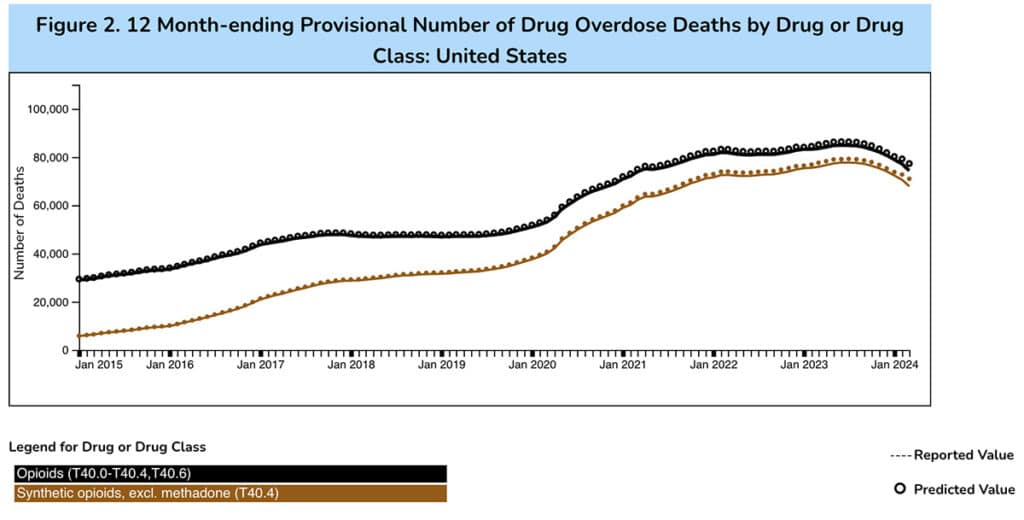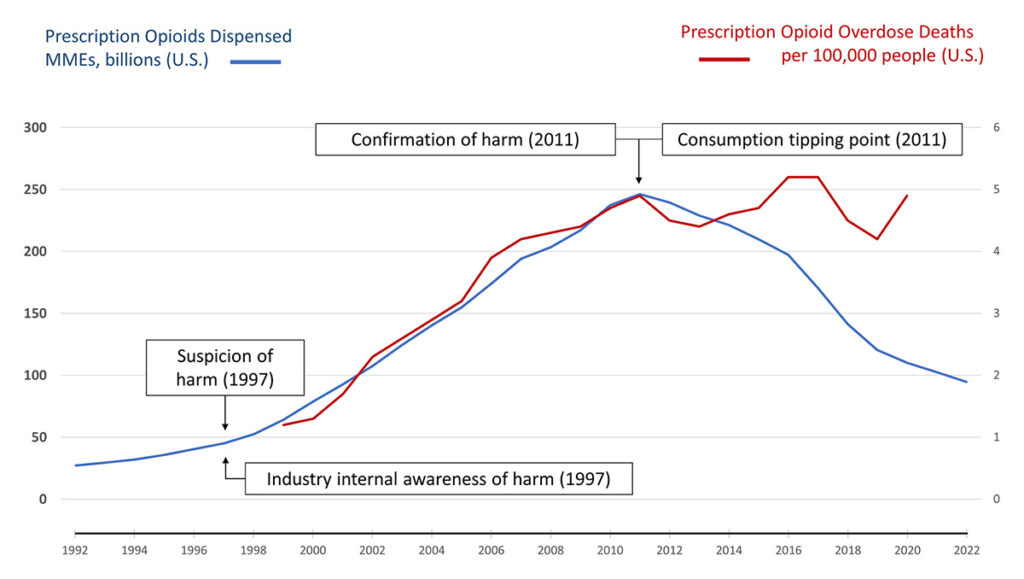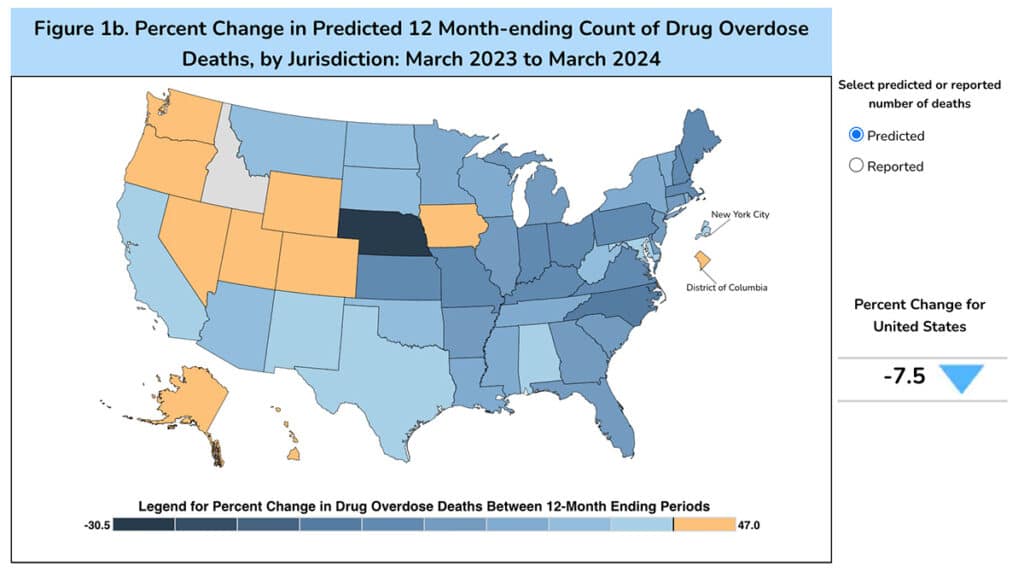Volcanoes are erupting in The Philippines, but on-fire Australia received some welcome rain. The Iran war cries have been called off and The Donald’s military powers are about to be hamstrung by the Senate. Meanwhile, his impeachment trial is starting, and we’re all on Twitter for a front-row seat.
What Could Go Right? Opioid Deaths Are Finally Falling
The first encouraging sign that the opioid crisis might be abating
This is our weekly newsletter, What Could Go Right? Sign up here to receive it in your inbox every Thursday at 5am ET. You can read past issues here.
Opioid Deaths Are Finally Falling
In March of 2023 the newsletter Fix the News reported that drug overdose deaths in the United States, including ones from opioids and synthetic opioids like fentanyl, may be plateauing or dipping. It was the first sign of a much-needed respite in the opioid crisis that has ruined so many lives for so many years. The data was from 2022, however, and still provisional.
Earlier this month, the Centers for Disease Control and Prevention (CDC) released the latest numbers. 2022 turned out to be more of a plateau or a gentle rise than a dip. But now, overdose deaths from opioids may have indeed peaked, with a drop beginning in the autumn of 2023. While the CDC notes that current data might be an undercount, it’s likely not one that would severely affect trends. You can see reported versus predicted counts in the chart below.

Deaths are still alarmingly high—over 100,000 annually, a substantial increase from pre-pandemic days. There is also no guarantee that the decline will hold. “We have been to false peaks before,” Daniel Ciccarone, a professor of family community medicine at the University of California, San Francisco, who studies the opioid epidemic, told Scientific American.
But there are reasons to think that this time may be for real.
Governing better: Methadone, a drug that helps wean people off an opioid addiction and has been around in the US since the 1960s, is playing a part in mitigating the crisis. Access is limited to methadone clinics, however, which clips its use. By contrast, in 2018, Congress approved legislation to allow newer buprenorphine-based medications, which work similarly to methadone, to be prescribed by doctors and picked up at regular pharmacies.
Naloxone, which reverses overdoses, was federally approved for over-the-counter use in 2023. And some states have legalized test strips so that people can check whether a party drug like cocaine or ecstasy may be contaminated by fentanyl. Even two or three milligrams of the stuff is lethal.
China has also played ball in recent years, taking measures “to stem exports of fentanyl to the US” in 2019, the Financial Times reports ($). Last week, Beijing announced that it would impose restrictions on three chemicals used to make fentanyl, although narcotics experts are wary of whether such controls will actually make a difference.
General awareness: Doctors have also stopped prescribing opioids as freely as they once did. A recently published study about market-driven epidemics—in other words, when companies aggressively market products with proven harms—looked at prescription opioids, among other substances. The authors found that consumption of those products starts to tip once “compelling evidence of harm, professional alarm, and an authoritative public health voice and/or public mobilization” together overcome “corporate marketing and resistance efforts.” For prescription opioids, that occurred in 2011.

Since then, prescriptions have fallen 62 percent.
The pandemic was a uniquely bad time: It could also be the case that what we’re seeing is simply a return to pre-pandemic numbers. Drug overdose deaths rose dramatically during the pandemic years, as did a host of other human ills, from poorer mental health to gun violence. Being locked in our houses away from other humans is not good for us. It also became much harder to access medical treatment across the board.
It’s possible, then, that drug overdoses are just following the same pattern as all of the other pandemic oddities. Most violent crime has returned to normal, we’re feeling less stressed out, and people have stopped being jerks on planes.
The fall in overdose deaths has not been consistent nationally. While many eastern states have seen between 10 and 20 percent declines, the states colored yellow below have seen considerable increases.

The Scientific American article chalks this up to differences in timing. Fentanyl went west about five years after it was introduced to eastern states. The US Drug Enforcement Administration has also cracked down on a particular Mexican cartel that supplies fentanyl to the east. The data have improved even within the last month, however. Alabama, Texas, New Mexico, and California were all registering increases in July, but decreases by August.
The trend here is neither definitive nor phenomenal. But it is encouraging.
What Could Go Right? S6 E17

Why have leading publications been obsessed with Donald Trump for so long? What’s the master thesis behind political and cultural schisms in the US? And why are the nation’s elite all talk and no walk about social justice? Zachary and Emma speak with Musa al-Gharbi, sociologist and author of We Have Never Been Woke: The Cultural Contradictions of a New Elite. They discuss The New York Times and other publications’ fascination with Donald Trump as a politician over the years, the journey of “jumping class,” and how Ivy League universities are schools for elites that turn away the disadvantaged. | Listen now
By the Numbers
85%: The drop in severe food insecurity in Brazil last year
69%: The decrease in US Covid deaths last year compared to 2022
25%: The share of US adults who now say drinking has ever been a cause of trouble in their family, the lowest since 1996
Quick Hits
💉 Scientists have developed a “holy grail” insulin, The Guardian reports, “that responds to changing blood sugar levels in real-time.” Instead of several times a day, patients who must inject insulin might have to do it only once per week in the future. While several different types of “smart” insulins are in development, trials have yet to begin.
🧬 A few progress lists: 11 breakthroughs helping to tamp down death rates from cancer, global immunization rates of children are holding steady and in some areas increasing, and new tools are being developed to prevent mosquitoes from carrying diseases like malaria and dengue fever.
🦠 Improvements for HIV treatment and prevention have been coming thick and fast lately. Here’s another: one shot that could permanently keep HIV at low levels, stopping the virus from developing into AIDS as well as transmission to another person. The shot injects an engineered virus that “steals” essential proteins from the HIV virus. Small human trials have started. (NYT $)
🌳 A 151-year-old banyan tree damaged by wildfires in Hawaii last year has survived and is showing signs of recovery. Locals are also making efforts to save other trees important to Hawaii, like the breadfruit tree, of which only two made it through the fires unscathed.
📱 Social media doesn’t have to be the divisive pit of outrage it often is. The Washington Post reports on an app in Vermont, Front Porch Forum, that has achieved widespread popularity by doing the exact opposite of most social media apps. The secret to its success is slow moving and heavy moderation. ($)
🚆 Southern California train travelers, rejoice: the nation’s first zero-emissions, hydrogen-powered hybrid train is coming to San Bernardino. See what it looks like here.
⚡ How states produce their electricity has changed dramatically in the past 20 years, with a mix of natural gas, wind, and some hydroelectric and nuclear power reducing dependence on coal. The New York Times has a great interactive graphic where you can look up your state’s power mix and how it has developed. ($)
🌡️ Research has found that Europe has warmed at a much faster rate than other parts of the world, with tens of thousands killed by hot weather last year. That figure would have been 80 percent higher, however, if not for effective adaptation against heat waves over the last two decades—public health efforts and changes in individual behavior, but also a natural adaptation of the human body to heat. Europeans’ minimum mortality temperature has risen 2.7 degrees Celsius between 2000 and 2019.
👍 The Food and Drug Administration has approved the first needle-free alternative to devices like EpiPen. It’s a nasal spray that counters symptoms of anaphylaxis, a life-threatening allergic reaction, about as well as injections currently on the market.
💡 Editor’s pick: Do student protests actually lead to significant change? They can. After students in Bangladesh recently ousted their unpopular prime minister, The Associated Press reviews other successful student-led protests throughout history.
TPN Member Originals
(Who are our Members? Get to know them.)
- Neoliberalism and its enemies, part 3 | Slow Boring | Matthew Yglesias
- A cure for our anxious young people | The Atlantic ($) | Arthur C. Brooks
- The surrender of the gods, part 2 | The Roots of Progress | Jason Crawford
- We need to make more New Yorks | Vital City | Richard Florida
- Sound and fury, cabbages and kings | The Edgy Optimist | Zachary Karabell
- Election countdown: Three lessons in speech-making | Breaking the News | James Fallows
- Kamala Harris picks Tim Walz as her running mate | Tangle | Isaac Saul
- Walzing into a saner foreign policy? | Nonzero | Robert Wright
- We need more Mister Walzes | Of Boys and Men | Richard V. Reeves
- Saving Yolo Art Center | The International Correspondent | Faisal Saeed Al Mutar
- What will the Google antitrust ruling mean for search—and all of us? | WaPo ($) | Bina Venkataraman
- Weapons of war: Higher ed | No Mercy/No Malice | Scott Galloway
- Playtime: What a magical encounter with a child taught me | Lucid | Ruth Ben-Ghiat
- Would Kamala Harris be our first Gen X president? | Rolling Stone | Alissa Quart



[…] Specialiștii se așteaptă ca numărul deceselor cauzate de opioide să revină la nivelul de dinainte de pandemie, care a dus la o creștere dramatică a acestora. (The Progress Network) […]